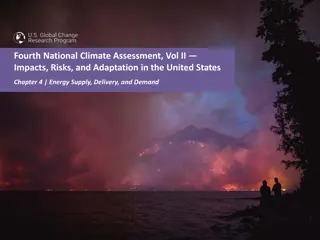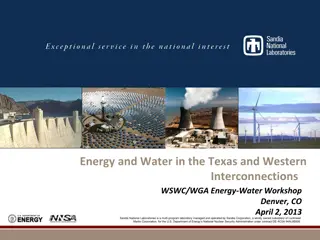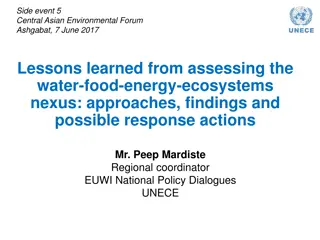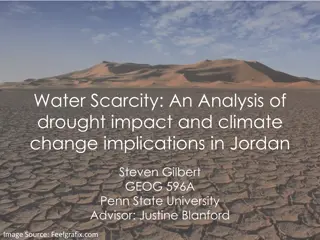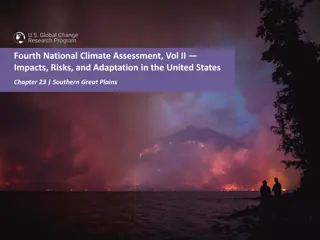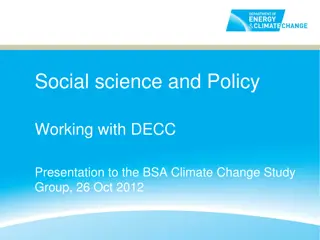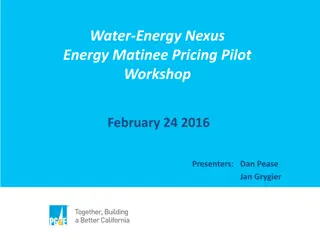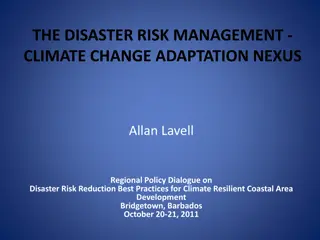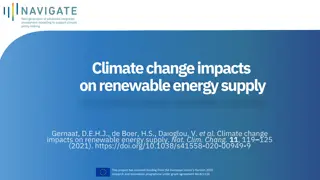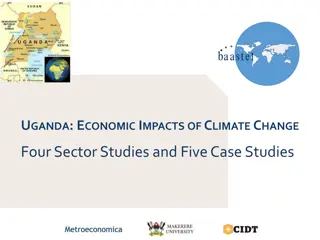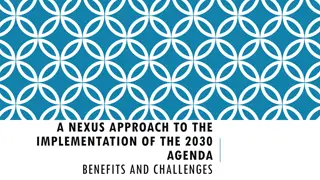Understanding the Food-Energy-Water Nexus and Climate Change Impacts
Explore the intricate relationship between food, energy, water, and climate change through the CLEWS modelling approach. Discover how greenhouse gas emissions, sector-wise contributions, and implications on agriculture and energy infrastructure. Gain insights into assessing policy robustness to climate change and the potential impacts on global mean temperature and land use.
Download Presentation

Please find below an Image/Link to download the presentation.
The content on the website is provided AS IS for your information and personal use only. It may not be sold, licensed, or shared on other websites without obtaining consent from the author. Download presentation by click this link. If you encounter any issues during the download, it is possible that the publisher has removed the file from their server.
E N D
Presentation Transcript
CLEWS Country Module 1. The food-energy-water nexus and sustainable development 2. The need for integrated planning: case studies 3. The CLEWS modelling approach 4. CLEWS case studies 5. Hands-on exercises with CLEWS
Adding climate allows assessment of policy robustness to climate change CLEWS quantifying the FEW-NEXUS Energy model Energy for fertilizer production Energy required for field preparation and harvest Biomass for biofuel production and other energy uses Energy for water processing and treatment Energy for water pumping Energy for desalination Water available for hydropower Water for power plant cooling Water for (bio-) fuel processing Greenhouse gas emissions Quantifies the food- energy- water nexus Climate Water model Land use model Precipitation temperature Water for biofuel crops (rain-fed and irrigated) Water needs for food, feed and fibre crops (rain-fed and irrigated)
Greenhouse gas emissions and the food-energy-water nexus Global emissions by sector 2.1% 3.2% Agriculture, forestry and other land use 23.1% Energy Electricity and heat 25.3% 12.2% Industry Agriculture 13.8% Residential 6.5% Land-use change & forestry Other energy 9.9% 64.4% 4.3% Waste Transport 14.2% Int'l bunkers Industry 18.1% Waste 2.9%
Greenhouse gas emissions from electricity generation 1200 1791 Emissions (g CO2-eq/kW h) 1000 800 600 400 200 0 Coal Gas CCS Biomass Geothermal Solar PV Solar CSP Wind Median value Nuclear Hydro Overall range Interquartile range
Climate change and the food-energy-water nexus Climate change is often said to manifest through water More frequent extreme weather events (e.g., more droughts and floods) Shifting precipitation patterns Potential for major impacts on agriculture Impact on energy infrastructure Sea level rise has dramatic consequences for land use Global mean temperature prospects
CLEWS Time horizon is typically one or more decades Intended for longer term assessments and studies Scenario-based analysis Explores alternatives, risks and uncertainties through scenarios and sensitivity analysis Assesses the role of technology and technological change Tests policies and measures Flexible Model user chooses system boundaries Model user chooses level of detail Model user chooses geographical coverage
Implementing a CLEWS assessment Current state and historical trends Main stress points Sectoral policies, plans, strategies Systems profiling Interlinkages among sectors Pressure points within and among sectors Focus on the nexus analysis Data availability Pre-nexus assessment Model development sector models to fully integrated models Model calibration Soft-linking of model inputs and/or outputs in the case of sector models Scenario design and development Model development
Implementing a CLEWS assessment, contd Analysis and interpretation of results Revise inputs/assumptions Conduct additional model runs (iterations) Analysis Report on the quantification of the impacts of sectoral interactions Suggestion of strategies and pathways towards sustainability Inform policymaking
Integrated assessment CLEWS Energy quantifying the FEW-NEXUS Water Land - Food AEZ Climate EMISSIONS EMISSIONS Emissions
Water management modelling Water for energy Water for nature Water for agriculture Water quantity Water quality Seasonality of flow Regulation Domestic water Water for navigation Water for recreation Water for industry
Water management model: critical questions How to allocate water to competing uses? How to best operate water infrastructure (e.g., dams, diversion works)? How water allocation, operation rules and constraints should adjust to new management directives? How to jointly manage water for irrigation and energy requirements?
The water model Required model inputs include: Definition of all catchment areas Real climatic data: rainfall, minimum and maximum temperature, humidity... All main rivers and reservoirs plus stream flow data and reservoir levels Modelling of existing canals/distribution systems Using GIS: land cover classes to calculate evapotranspiration Water demand data (urban and agricultural) according to national statistics and population density
The energy model Used to represent physical flows, capacities and energy balances through an energy system Accounting models: Can be used to assess the impacts of predetermined pathways for development, e.g., LEAP, MAED Simulation models: Represent decisions of actors within the system Potential for replacing existing technologies with low-carbon, more efficient or cost effective alternatives Optimization models: Can be used to maximize benefits; or minimize costs, e.g. OSeMOSYS, MESSAGE, MARKAL Technology learning rates, resource availability, technical limitations, vintage of infrastructures, penetration rates, environmental criteria, costs, etc. directly affect the optimal system design.
Energy system model: critical questions What are the investment requirements in generation and network infrastructure and their timing to meet electricity demand and when? How can energy security be enhanced? What is the cost of expanding modern energy services? What technologies and fuels grant the lowest cost, most reliable energy mix? What is the scope for producing biofuels and generating electricity form large-scale solar photovoltaic parks or wind farms? What are the water requirements e.g., water for cooling, hydropower, irrigation of biofuels? What pollutants are emitted and in what quantities?
The land-use model AEZ AEZ AGRO-ECOLOGICAL ZONING Inputs Climate data Detailed soil map and data from soil profiles Slopes and marginal land GIS data for land cover Irrigated areas Output Grid map showing optimal crops, and potential water use and yield, plus a crop calendar
Agro-ecological modelling Geospatially based analysis of agricultural output to assess: What is the potential yield of a range of crops in each region? What are the water requirements for each crop in each modelled sector? How do different climate scenarios affect crop yield? Quantification of input requirements to achieve a certain level of yield.
Agro-ecological modelling Example: rainfall pattern and water demand by crop
Climate representation Climate is defined by the major assumptions in land-use, water management and energy systems models. Apparent need for consistency e.g., greenhouse gas emissions limits versus long-term estimates for air temperature and precipitation Accounting of greenhouse gas emissions Temperature and precipitation affecting agricultural production Solar insolation affecting photovoltaic and concentrated solar power generation Precipitation affecting hydropower and water irrigation demand, quantifying seasonality of availability Interlinkages between effects across sectors are highlighted
Optimization in the integrated CLEWs tool Representation of the physical system (i.e., bottom up ) Technologies are described by their technical and economic characteristics Full value chains (e.g., well-to-wheel or field-to-fork) Web of interconnected value chains Meets consumer demands Balance of supply and demand Clears each commodity market in every value chain Identifies cost-effective strategies subject to constraints Configures system to find deployment and utilization patterns that meet demands at lowest possible cost
Integrated CLEWS optimization tool Inputs Outputs Demand curves Technology performance Technology cost (capital, operation and management) Commodity cost (extraction cost, import cost) Cost of capital Emissions intensity Constraints (environmental, regulatory, policy, market, etc. ) Investment (physical units and cost) Total production capacity Operating costs Asset utilization Output (physical units) Fuel expenditures Emissions Shadow prices
Concluding remarks A flexible modelling tool to quantitatively assess the food-energy-water nexus in the context of climate change Integrated entry point to inform sustainable development policies, including related to the 2030 Agenda and Paris Agreement Retains sector relevance while providing an integrated assessment Can contribute to institutional coordination for integrated policy formulation







